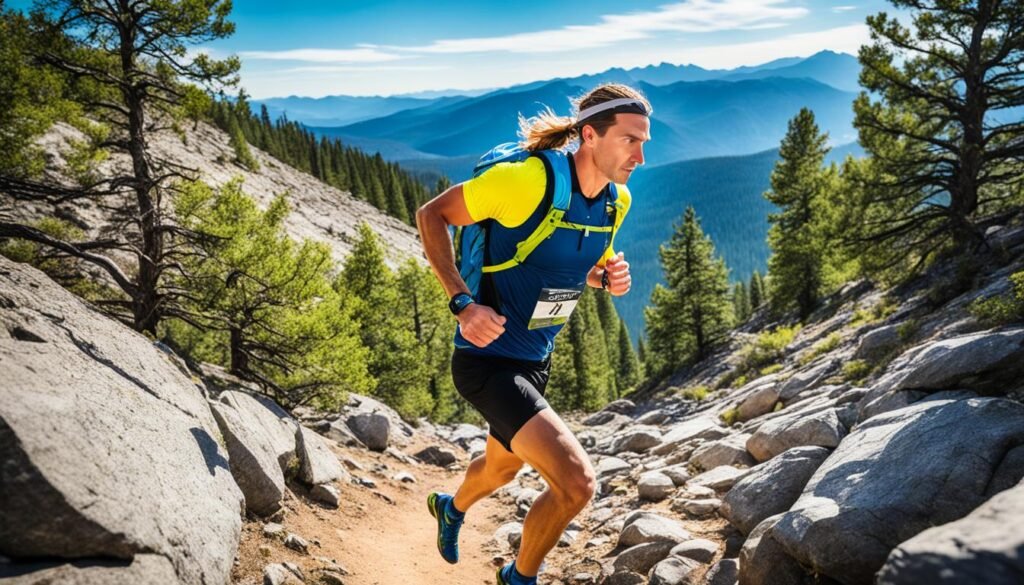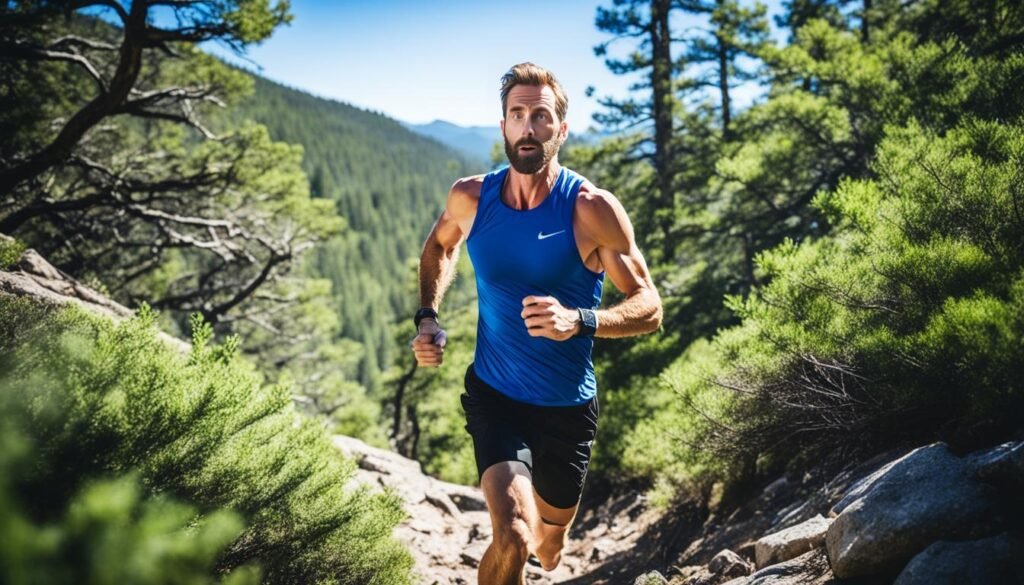Trail running is a thrilling option compared to road running. It’s perfect for those who love nature, want a challenge, or are looking for a new fitness routine. This guide will help you start your journey into trail running.
It’s not just about running on dirt paths. You’ll navigate rugged trails, adjust to various terrains, and see the outdoors in a new way. This sport is becoming more popular in the US for its health perks.
When you start trail running, you do more than exercise. You enter a world that improves health and builds community. Experts say it boosts heart health, mental strength, and brings runners closer together.
Key Takeaways
- Trail running offers a unique and exciting alternative to road running.
- It provides substantial physical and mental health benefits.
- Trail running for beginners involves adapting to varied terrain and scenery.
- Expert insights emphasize the holistic benefits of this sport.
- Joining the trail running community can enhance your experience.
Why Trail Running: The Benefits
Trail running goes beyond just physical health. It also boosts your mental state and connects you with others. These perks encourage many to start running on trails.
Physical Benefits of Trail Running
Trail running offers various physical benefits. Running on uneven ground and hills makes your body work differently. This improves your heart health, muscles, balance, and coordination. Research from the American Council on Exercise shows it also increases endurance and decreases disease risk.
Mental Health Benefits
Trail running is great for your mind too. It’s proven to lessen stress and anxiety and make you happier. The outdoors offers fresh air and natural sounds, boosting your mental sharpness and emotional balance. So, trail running is good for both your body and mind.
Environmental and Social Benefits
There are environmental and social gains from trail running as well. Being part of a trail running group creates friendship and aid unique to this activity. It connects you with nature lovers who care about the planet. The trail running community is big on keeping nature safe while building strong friendships.
Choosing the Right Trail Running Gear
Getting the right gear is essential for your trail running success and safety. You need shoes that grip well on tough terrains and hydration packs to stay energized. The right equipment can really improve your trail running adventure.
Trail Running Shoes
Trail running shoes help you stay stable on uneven ground. Brands like Salomon, Brooks, and Altra are known for their strong and comfy shoes. Think about the trails you’ll run on and choose shoes that fit well to avoid any foot problems.
Apparel and Accessories
The clothes you wear can change how you feel while running. Choose clothes that are light and wick away sweat. Companies like Patagonia and North Face have great trail running clothes, from jackets to base layers. Also, wear hats, gloves, and sunglasses for protection.
Hydration and Nutrition
It’s important to stay hydrated and eat well, especially on longer trails. CamelBak offers running packs that make it easy to drink water while you run. Carry some energy gels or bars to keep up your strength. Getting advice from a nutritionist can also help boost your performance.
How to Find Outdoor Running Trails
Finding the right Outdoor Running Trails is the first step for trail runners. A good trail makes running fun and keeps you safe. Let’s look at how to find great trails nearby.
Exploring Local Parks and Nature Reserves
Start with your local parks and nature reserves. They usually have trails for all levels. Check your city’s park directory or website for info on hiking and running paths.

Using Apps and Websites
If you’re into tech, Trail Running Apps and websites can help. Trail Running Locations become easier to find. Apps like AllTrails and Trail Run Project offer reviews and GPS tracking. For more on trail running, read this article.
Joining Trail Running Communities
Joining local trail running groups helps a lot. You get to meet others who enjoy Outdoor Running Trails. These groups share tips and organize runs. It’s a great way to make your running journey better.
Finding the right trails is key for beginners. You can use local guides, tech, or join groups. All these help in finding the best trails for you.
Beginner’s Guide to Trail Running: What to Expect
Starting your journey with trail running is exciting but tough. It’s key to know there’s a big learning curve. When you move from road running to trails, you’ll see many challenges. These test both body and mind.
Beginners often find trail runs full of surprises due to varied terrains. Trails have uneven ground, roots, and stones, not like flat roads. At first, this may seem hard. Yet, it offers a unique and rewarding running feeling.
Coaches see new runners making early mistakes, like not pacing well or not drinking enough water. It’s vital to start slow to get used to trail running. Staying hydrated and eating right are key for a good run.
Having the right gear is also very important, experts say. Good shoes and clothes that keep you dry help a lot. They make you comfortable and help prevent hurts.
“Trail running is about more than just physical stamina; it’s a mental game of overcoming ever-changing obstacles,” says renowned ultra-marathoner Scott Jurek.
- Equip yourself with robust trail running gear to tackle diverse terrains.
- Stay hydrated and nourish your body to maintain your energy levels.
- Begin at a steady pace to familiarize yourself with the trails.
In summary, trail running brings together tough tests and great triumphs. Starting this adventure gets you ready for a path of both learning and growing. The main thing is to face the challenges of trail running with a hopeful attitude and proper prep.
Trail Running Tips for Beginners
Trail running lets you enjoy nature and get a great workout. It’s important for beginners to learn how to improve their runs over time. Here are some key tips to help you start strong.
Start Slow and Build Up
Begin with easy runs and slowly increase your speed and distance. This approach helps avoid injuries and burnout. Coaches say to focus on trail running pacing. That means starting slow, then building speed and endurance. Remember, being consistent is vital. Adding interval training can also help your muscles adapt and recover better.
Pay Attention to Your Form
Good trail running form helps prevent injuries and makes you more efficient. Experts suggest keeping your shoulders loose and your core tight. Keep your gaze ahead to spot obstacles. A short stride and a slight forward lean improve your ability to handle rough terrain. Engage your glutes and hamstrings to drive your motion. This will make your runs smoother.
Learn to Navigate Trails
Knowing how to find your way is essential for safe trail running. Learn map reading and use GPS devices, say orienteering experts. These are key trail running techniques. Keep an eye on trail markers and landmarks to avoid getting lost. Running with a group teaches you tips from those with more experience.
Starting with these tips lays a strong base for your trail running. You’ll need to focus on trail running techniques, work on your trail running form, and get better at trail running pacing. These skills will equip you to tackle tougher trails confidently.
Trail Running Safety Tips
Prioritizing Trail Running Safety is a must for both new and seasoned runners. Weather can change fast, and rough paths are common. These make Trail Running Hazard Prevention key in getting ready.
Preparing for Weather and Terrain
Knowing the weather and land before you start is key to Trail Running Safety. Check the forecast and have the right gear to stay safe. For example, getting shoes for trail with good grip helps on wet paths. Wearing layers lets runners deal with weather shifts, preventing cold or heat issues.

Also, learning the lay of the land helps avoid getting lost. Using apps like AllTrails for maps helps with not knowing your way.
Avoiding Injuries
Talking to sports health experts shows the need for good warm-up moves to lower the chance of hurts. Stretching your lower body improves readiness. Doing regular strength and co-ordination exercises is also key to Trail Running Hazard Prevention.
Pace yourself right from the start to adapt to trail running. Adding rest days helps in healing and stops injuries from too much use.
Emergency Protocols
Talking about Trail Running Preparedness, having an emergency plan is vital. Carrying a simple first aid kit, a whistle, and a charged phone is advised by search and rescue experts. Knowing CPR and basic first aid can save lives. Also, tell someone where you’re going and when you’ll be back to ensure safety if things go wrong.
Marking emergency exits on your map and learning local emergency numbers is smart. Knowing the closest medical centers raises Trail Running Safety.
| Safety Measure | Description |
|---|---|
| Wear Appropriate Gear | Use trail-specific shoes and clothing suitable for weather changes. |
| Warm-Up and Stretch | Engage in exercises targeting calves, quads, hamstrings, and ankles. |
| Emergency Kit | Carry essentials like a first aid kit, whistle, and cell phone. |
| Informed Contacts | Tell someone your route and expected return time. |
By following these Trail Running Safety Tips, you can enjoy the sport while managing potential risks confidently.
Trail Running Workouts for Newcomers
Adding different workouts to your Trail Running Training boosts your performance and lowers injury risk. A varied Trail Running Exercise Plan is key, no matter if you’re new or experienced.
Interval Training and Hill Work
Interval training and hill workouts are key for effective Trail Running Training. They bolster your endurance and strength. This helps you handle difficult terrains better.
- Interval Training: Mix short, intense running bursts with low-intensity periods. It’s good for your heart and speed.
- Hill Work: Hill workouts strengthen your legs and improve uphill and downhill running. Try sprints and steady climbs.
Strength and Conditioning
Strength exercises are vital in your Trail Running Plan. They build muscle, boost stability, and prevent injuries. Here are crucial exercises:
- Squats and Lunges: These target quads, hamstrings, and glutes, important for trail runners.
- Core Workouts: A strong core stabilizes your body and improves form. Add planks, Russian twists, and leg raises to your workouts.
- Plyometrics: Plyometrics like box jumps and burpees increase agility and help on uneven paths.
Recovery Routines
Recovery is critical to keep top performance and avoid injuries. A solid Trail Running Recovery schedule helps your body recuperate and adapt.
“A comprehensive recovery plan includes hydration, rest, and active recovery,” says Dr. Max Murray.
- Hydration: Stay well-hydrated before, during, and after runs, especially when it’s hot.
- Stretching: Stretch after runs to ease muscle tightness and boost flexibility. Focus on calves, hamstrings, and hips.
- Massage and Foam Rolling: These methods lessen muscle soreness and improve circulation for faster recovery.
| Workout Type | Benefits | Recommended Frequency |
|---|---|---|
| Interval Training | Improves speed and cardiovascular health | 2-3 times per week |
| Hill Work | Builds leg strength and endurance | Once a week |
| Strength and Conditioning | Enhances stability and prevents injuries | 2-3 times per week |
| Recovery Routines | Promotes muscle healing and flexibility | Daily, post-run |
Exploring Trail Running Races and Events
Trail running has grown into more than just running alone. It’s now a community activity. You can either compete or enjoy the views on scenic trails. There are many events that welcome all skill levels.
Trail Running Races let you see how you stack up against others. You might know of the Western States 100-Mile Endurance Run or the TransRockies Run. These events have tough trails and let you meet other runners.
But trail running isn’t all about competition. Trail Running Festivals mix fun and running. The Trail Running Ultra Weekend is perfect for both new and experienced runners. It’s a chance to meet others who love running.
| Event | Location | Date | Distance |
|---|---|---|---|
| Western States 100 | California | June | 100 miles |
| TransRockies Run | Colorado | August | 120 miles |
| Trail Running Ultra Weekend | Oregon | September | Various |
Joining trail running events can make the sport much more fun. It pushes you and connects you with others who are supportive. It’s time to mark your calendars and plan your next adventure!
Conclusion
Your trail running journey is more than just enjoying nature. It’s also about changing your way of life. This guide helps you understand trail running’s benefits, choose the right gear, and find beautiful trails. Each step prepares you for a great trail running experience.
Beginning your trail running adventure? Remember that being prepared and safe is key. Start slowly, focus on your form, and learn how to move on trails. This will ensure you have a fun and safe adventure. By joining trail running events and practicing, your love for the sport will grow. This will improve both your body and mind.
If you’re new to trail running or need more advice, our team is here to help. Don’t hesitate to reach out to us with questions. We are eager to help and provide quick answers. Remember, you’re not alone in this exciting journey. Let’s embrace the trail running life together!
FAQ
What is trail running?
Trail running means running outside, often in places like forests or mountains. It’s different from road running because the ground is uneven. This makes it both fun and adventurous.
Why should I choose trail running over road running?
Trail running is good for you in many ways. It can make your heart and muscles stronger. Plus, being in nature can make you feel happier and less stressed. It’s also a great way to make friends and appreciate the outdoors.
What gear do I need for trail running?
You’ll need shoes made for trails that help you keep your footing. Wear clothes that are right for the weather, and carry water to stay hydrated. Some folks also bring snacks for energy during long runs.
How can I find good trails for running?
Look for parks or nature reserves near you. Use apps like AllTrails or websites like TrailLink. Joining running groups can also introduce you to new places to run.
What should I expect as a beginner in trail running?
Starting out, you’ll see that trails have ups and downs and the weather can change. Begin slowly, watch how you move, and enjoy the adventure ahead.
What are some tips for beginners to improve in trail running?
Start at a comfortable pace and slowly go faster. Make sure you’re running the right way to not get hurt. Getting to know the trail signs and maps will also help you not get lost.
What safety precautions should I take when trail running?
Dress right for the weather and use the correct gear. Tell someone where you’re going. Carry a first aid kit. Know about the local wildlife, how to avoid getting hurt, and what to do if something goes wrong.
What types of workouts can help me prepare for trail running?
Do exercises like interval training and running up hills to get stronger. Work on your overall fitness with strength training. Don’t forget to rest and recover to stay injury-free and do your best.
Are there trail running races and events I can participate in?
Yes, there are lots of trail running events all over the world. They range from short races to ultra-marathons. You can find races and events through groups and organizations that focus on trail running.







